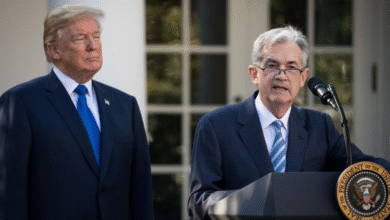Bitcoin Rebound: Market Reacts After Ceasefire News

In recent days, Bitcoin has demonstrated a significant rebound, recovering from its dip below $100,000 for the first time in over 46 days to close the week at slightly over $107,000. This shift in the Bitcoin price not only marks a pivotal moment for the cryptocurrency but also reflects the overall buoyancy of the crypto market, which saw its total market capitalization rise from around $3.2 trillion to approximately $3.4 trillion. The catalyst for this resurgence can be linked to global geopolitical developments, particularly the ceasefire agreement between Iran and Israel, which eased tensions in the region and boosted investor confidence in various financial assets, including Bitcoin. As the crypto market reacts positively to such news, Bitcoin news is increasingly circulated among traders looking to capitalize on potential cryptocurrency gains. Therefore, this rebound serves as a reminder of Bitcoin’s volatility and resilience amid fluctuating market dynamics.
Recently observed trends highlight a notable recovery in Bitcoin’s value, signifying an upward trajectory for the leading digital currency. After breaching the $100,000 threshold for the first time in 46 days, Bitcoin managed to stabilize above $107,000, igniting discussions within the financial community. This cryptocurrency resilience can be attributed to favorable news surrounding geopolitical events, which have positively influenced crypto market capitalization. As investors engage with these developments, new narratives surrounding digital currencies emerge, showcasing not only Bitcoin’s price fluctuations but also the broader implications for altcoins and the entire crypto landscape. With significant gains being reported across various tokens, it is evident that the cryptocurrency market is navigating a complex web of global events and investor sentiments.
Bitcoin Rebound Fuels Market Optimism
The recent rebound of Bitcoin, after falling below the $100,000 threshold, has sparked renewed optimism among cryptocurrency investors. Ending the week at just over $107,000, Bitcoin’s resilience indicates a potential recovery in the crypto market. This substantial price movement can partly be attributed to the positive market sentiment following the Iran-Israel ceasefire, which alleviated fears of broader geopolitical tensions impacting global trade. Investors are closely monitoring Bitcoin price fluctuations as they reflect wider economic trends, especially during times of crisis. The crypto market capitalization jumped from approximately $3.2 trillion to $3.4 trillion, highlighting the confidence returning to the market.
The correlation between Bitcoin’s price and global events has become increasingly evident. As tensions subsided in the Middle East, many traders opted to reinvest in cryptocurrency, perceiving it as a safe haven asset. The Bitcoin news surrounding its rebound not only drove individual investment decisions but also spurred institutional interest, further solidifying its role in a diversified portfolio. This recovery phase demonstrates how external political situations, like the recent ceasefire, can significantly influence Bitcoin’s performance and investor psychology.
Impact of the Iran-Israel Ceasefire on Cryptocurrency Gains
The ceasefire between Iran and Israel has had immediate effects on cryptocurrency gains, particularly in the realm of Bitcoin and other altcoins. Investors responded positively to the news, evident in the swift increase of the crypto market as tensions decreased. The assurance that hostilities would not escalate encouraged traders to step back into the market, resulting in substantial gains across various cryptocurrencies. Tokens such as HYPE, Chainlink, and Solana saw significant percentage increases, showcasing how geopolitical stability can correlate with profitability within the crypto space.
Beyond just Bitcoin, the entire cryptocurrency landscape demonstrated resilience, with the total market capitalization reflecting trust in digital assets. The ceasefire contributed to a broader sense of security that encouraged buying pressure across the board. Traders attending the Bitcoin market were quick to recognize that lessening international conflict could lead to a refreshed influx of capital, signaling a recovery phase across numerous cryptocurrencies. As such, these events highlight the interconnectedness of geopolitical dynamics and financial markets, particularly in the volatile world of cryptocurrencies.
Analyzing the Crypto Market Capitalization Growth
The shift in crypto market capitalization from $3.2 trillion to $3.4 trillion illustrates a significant influx of investment following the recent geopolitical developments. This growth points to the adaptable nature of cryptocurrencies in response to global events, especially in times of crisis. The increase in market capitalization also reflects an overall confidence in the sustainability of the cryptocurrency ecosystem, with digital assets like Bitcoin leading this charge. As more investors allocate resources into crypto, there is a potential for ongoing growth, making the sector an attractive option for those diversifying their portfolios.
Market participants are now more aware of how external events, such as international ceasefires or elections, can ripple through the cryptocurrency valuations. The recent increase, combined with Bitcoin’s robust price performance, signals a shift towards increased institutional participation as well. These dynamics provide insights into how the crypto market continues to evolve, adapting to market sentiment heavily influenced by news cycles. As the market adjusts, understanding these factors becomes crucial for investors aiming to navigate the complexities of the cryptocurrency landscape.
Bitcoin’s Role as a Safe Haven Asset
Bitcoin’s status as a safe haven asset has been reinforced by its recent performance amid geopolitical instability. When conflicts escalate, traditional markets often experience volatility, prompting investors to seek refuge in decentralized and digital assets. The recent rebound over $107,000 post-ceasefire illustrates Bitcoin’s potential to weather economic turbulence better than conventional investments. This emerging trend highlights a shift in how investors perceive Bitcoin, particularly during uncertain times.
As confidence in Bitcoin grows, many analysts argue that its decentralized nature is a crucial factor contributing to its durability as a safe haven. Unlike traditional currencies, Bitcoin is not susceptible to the direct impacts of central bank policies or national crises. This characteristic has captured the attention of both retail and institutional investors alike, who are increasingly looking towards cryptocurrencies as a viable alternative in their asset allocation strategies. As Bitcoin continues to reaffirm its value proposition, its reputation as a safe haven is solidifying within the investment community.
The Influence of Geopolitical Events on Bitcoin Price
Geopolitical events often serve as catalysts for Bitcoin price fluctuations, with the Iran-Israel ceasefire being a prime example. The recent conflict drew global attention, causing investors to reassess their digital asset holdings based on expected volatility. When news of a ceasefire emerged, Bitcoin’s price responded positively, demonstrating its sensitivity to international developments. This situation emphasizes the importance of monitoring global events as they have immediate and lasting effects on cryptocurrency valuations.
Furthermore, the interconnected nature of global economics means that investors must remain vigilant as geopolitical tensions can create both risks and opportunities. The swift rebound of Bitcoin post-ceasefire showcases the potential for sudden price increases in response to favorable news. Understanding these dynamics can allow traders to position themselves effectively, capitalizing on market movements that arise from the ever-changing political landscape.
Decentralized Finance Tokens and Market Gains
The recent hike in the crypto market capitalization can be significantly attributed to the performance of decentralized finance (DeFi) tokens. Chainlink, for instance, has seen substantial growth following the geopolitical developments, demonstrating robust community support and utility within the DeFi sector. The ability of such tokens to gain traction during market rallies is indicative of the increasing relevance of decentralized applications and blockchain technology in everyday finance.
DeFi tokens are not only bolstering their individual markets but are also contributing to the overall cryptocurrency surge, making them integral to the crypto ecosystem’s health. As more investors recognize the utility provided by DeFi platforms, these projects are likely to attract additional capital, further enhancing market gains. Consequently, the synergy between Bitcoin and DeFi tokens exemplifies how different segments of the cryptocurrency market can prosper concurrently, particularly in a recovering market.
Trends in Altcoin Performance Amid Bitcoin Rebound
While Bitcoin remains the benchmark of the crypto market, recent trends indicate that altcoins are also experiencing significant momentum. The performance of tokens like HYPE and Chainlink during this rebound period underscores the diverse opportunities available to investors. As Bitcoin breaks through psychological barriers, altcoins tend to follow suit, attracted by the bullish sentiment driving mainstream interest in cryptocurrencies.
Analyzing altcoin performance provides crucial insights into market health, as many traders look for opportunities beyond Bitcoin. The gains seen in Solana and other altcoins over recent weeks highlight how these cryptocurrencies can capitalize on Bitcoin’s performance while also paving their paths. As more altcoins begin to demonstrate their unique utilities and value propositions, they contribute to the overall diversification of the crypto market, making it an exciting landscape for investors.
Market Reactions to Bitcoin News and Events
Bitcoin news often triggers varied reactions within the market, shaping trading strategies and investor sentiment. News surrounding geopolitical tensions or regulatory shifts can lead to immediate spikes or drops in Bitcoin’s value, prompting traders to act quickly. For instance, the announcement of a ceasefire resulted in a positive market response, showcasing how Bitcoin can benefit from favorable news in its broader ecosystem.
Moreover, these reactions highlight the importance of remaining informed about Bitcoin news as it directly influences market dynamics. Investors who stay attuned to the latest developments can position themselves advantageously, leveraging market shifts to maximize their returns. As Bitcoin continues to be a focal point for media coverage, understanding its impact on the overall crypto market can assist investors in making informed decisions.
Future Outlook for Bitcoin and Cryptocurrency
The future outlook for Bitcoin and the surrounding cryptocurrency market appears promising in light of recent rebounds and market growth. As Bitcoin consolidates above the $107,000 mark, many analysts speculate continued upward momentum fueled by institutional investments and growing public interest. The increasing acceptance of Bitcoin as both a trading asset and a store of value positions it favorably for the coming months, especially if geopolitical tensions continue to stabilize.
Moreover, as cryptocurrencies gain more mainstream acceptance, the potential for Bitcoin to be regarded as a digital gold remains a focal point for many investors. The overall trend towards digital currency adoption, combined with Bitcoin’s resilience during market fluctuations, suggests that its role in global finance is only set to grow. Consequently, as the cryptocurrency landscape evolves, Bitcoin may not only sustain its dominance but may also redefine its status in financial markets worldwide.
Frequently Asked Questions
What factors contributed to the recent Bitcoin rebound?
The recent Bitcoin rebound above $107,000 was primarily influenced by the conclusion of the Iran-Israel conflict, which alleviated fears of a broader regional war. This geopolitical stability encouraged investor confidence, leading to increased activity in the crypto market and contributing to a rise in Bitcoin’s price.
How did the Iran-Israel ceasefire impact Bitcoin price?
The Iran-Israel ceasefire had a significant positive effect on Bitcoin price, allowing it to rebound from a dip below $100,000 to end the week above $107,000. This news helped boost overall market sentiment within the cryptocurrency sector, reflected in the increased crypto market capitalization from $3.2 trillion to $3.4 trillion shortly after the announcement.
Is the Bitcoin rebound indicative of a longer-term trend in cryptocurrency gains?
While the Bitcoin rebound is a positive sign, it’s essential to consider broader market trends and factors, such as regulatory changes and macroeconomic conditions. The recent crypto market capitalization increase suggests growing investor confidence, but sustained gains require monitoring ongoing developments in Bitcoin news and the overall market sentiment.
What does the recent Bitcoin rebound mean for crypto market capitalization?
The Bitcoin rebound has catalyzed a surge in crypto market capitalization, which grew from approximately $3.2 trillion to $3.4 trillion in response to the bullish sentiment following the Iran-Israel ceasefire. This trend highlights the interconnectedness of geopolitical events and cryptocurrency performance.
Can we expect further Bitcoin price increases following the recent rebound?
While the recent Bitcoin rebound has set a positive tone, predicting future price increases can be complex. Market conditions, investor sentiment, and potential geopolitical developments must be closely monitored to assess the likelihood of sustained upward movement in Bitcoin’s price.
What cryptocurrencies gained the most during the Bitcoin rebound?
During the Bitcoin rebound, notable cryptocurrencies such as HYPE, Chainlink (LINK), and Solana (SOL) experienced significant gains, with HYPE rising 7.2% and LINK climbing 5.3%. This uptick aligns with the broader recovery in the crypto market as investors reacted positively to the rebound in Bitcoin price.
How does Bitcoin’s volatility affect its rebound potential?
Bitcoin’s inherent volatility can make rebounds both rapid and uncertain. While recent news such as the Iran-Israel ceasefire has temporarily stabilized the price, future fluctuations are likely due to market sentiment, regulatory changes, and global economic events that could impact Bitcoin’s rebound potential.
| Key Point | Details |
|---|---|
| Bitcoin Price Movement | Bitcoin rebounded to above $107,000 after dropping below $100,000. It rose from $101,000 to $108,000 in a short span. |
| Crypto Market Capitalization | The overall market cap increased from approximately $3.2 trillion to $3.4 trillion following the ceasefire news. |
| Impact of Geopolitical Events | The ceasefire between Iran and Israel stabilized market fears and contributed to Bitcoin’s rebound. |
| Top Gainers | HYPE rose by 7.2%, LINK gained 5.3%, and SOL increased by 4.3%. |
| Top Losers | Cardano (ADA) dropped by 3%, while Matchain faced a severe decline of over 50%. |
Summary
The Bitcoin rebound signifies a positive turn in the cryptocurrency market following critical geopolitical events. After plummeting below $100,000 for an extended period, Bitcoin’s rise above $107,000 showcases how external factors, such as the recent Iran-Israel ceasefire, can greatly influence market dynamics. Investors reacted favorably to these developments, sparking a broader recovery in the cryptocurrency sector, which also saw a notable increase in overall market capitalization. Overall, the situation underlines the volatility and responsiveness of Bitcoin and the crypto market to real-world events.




